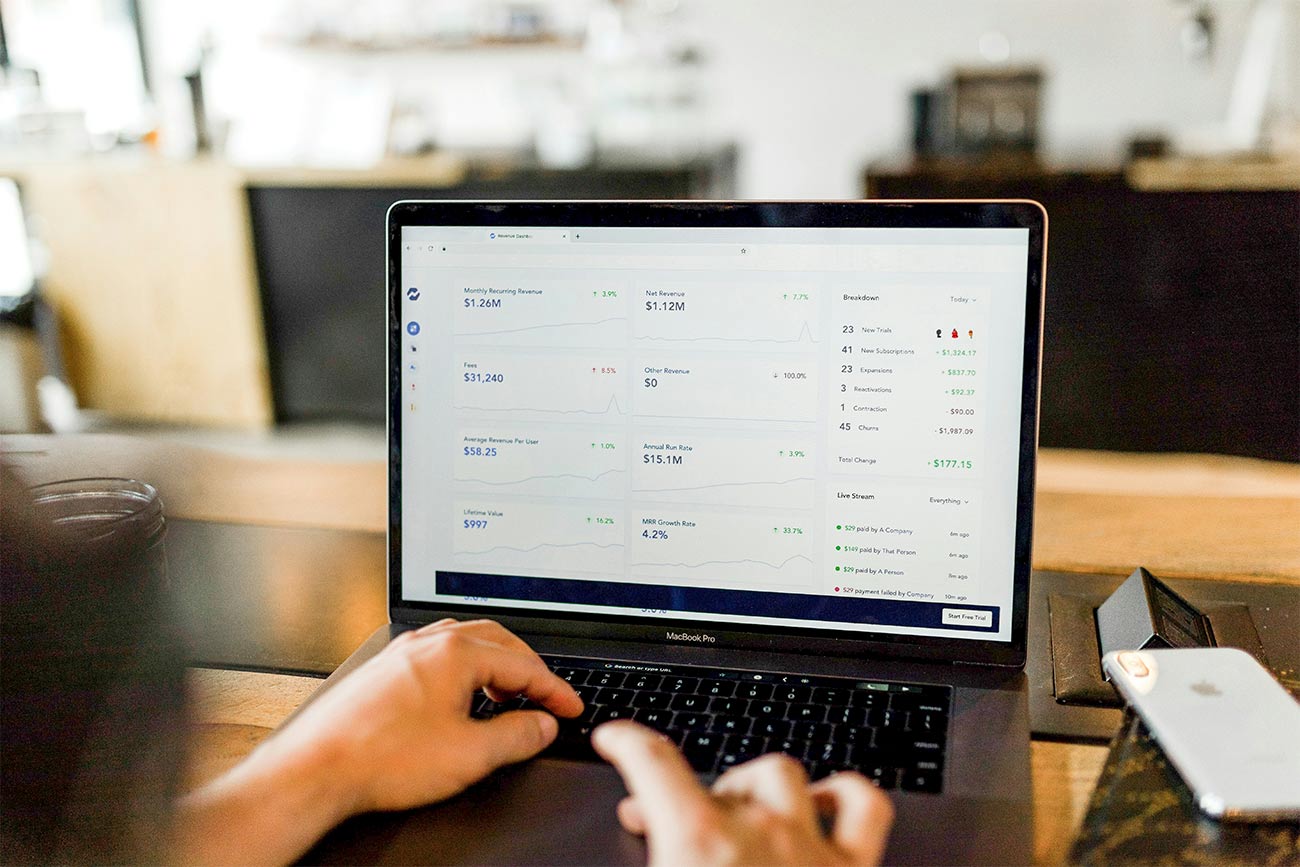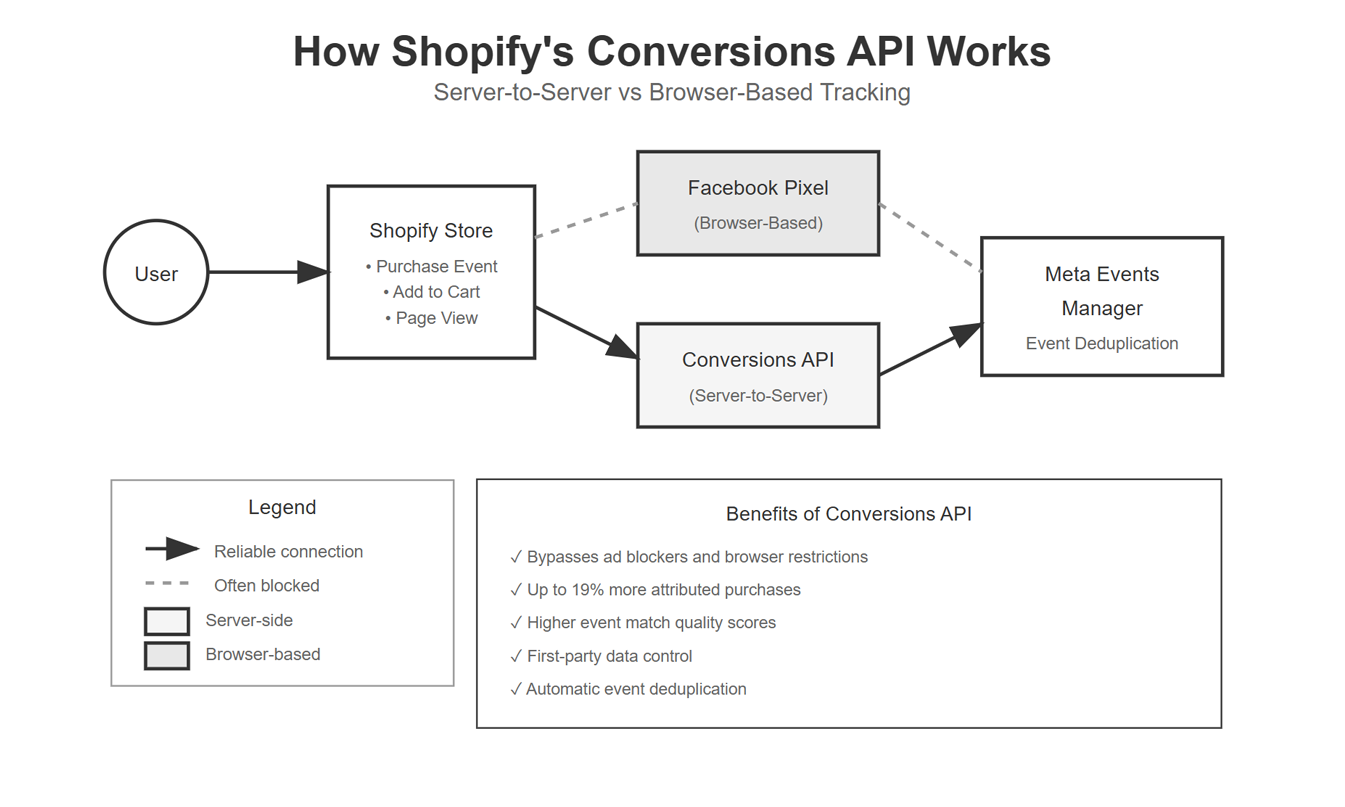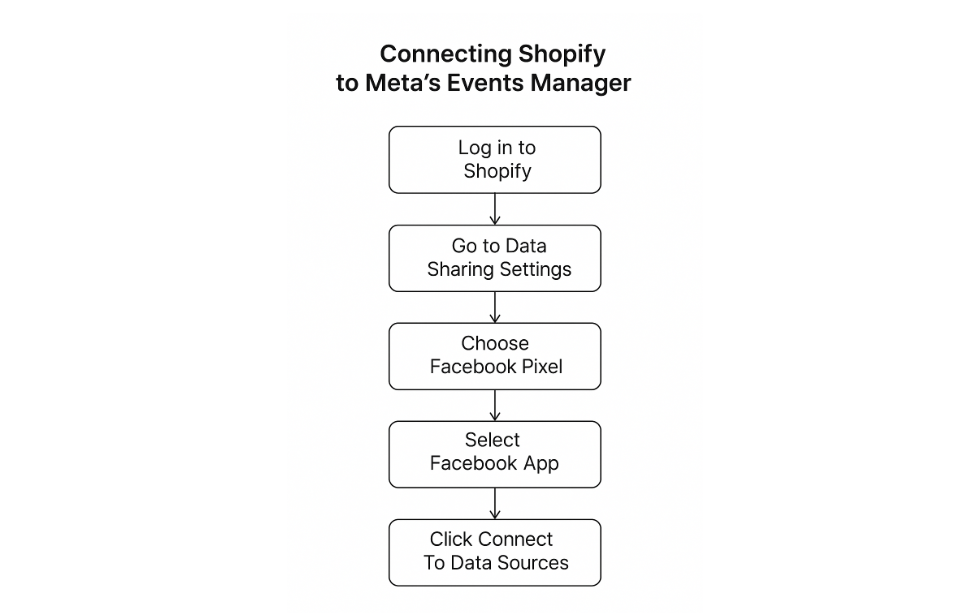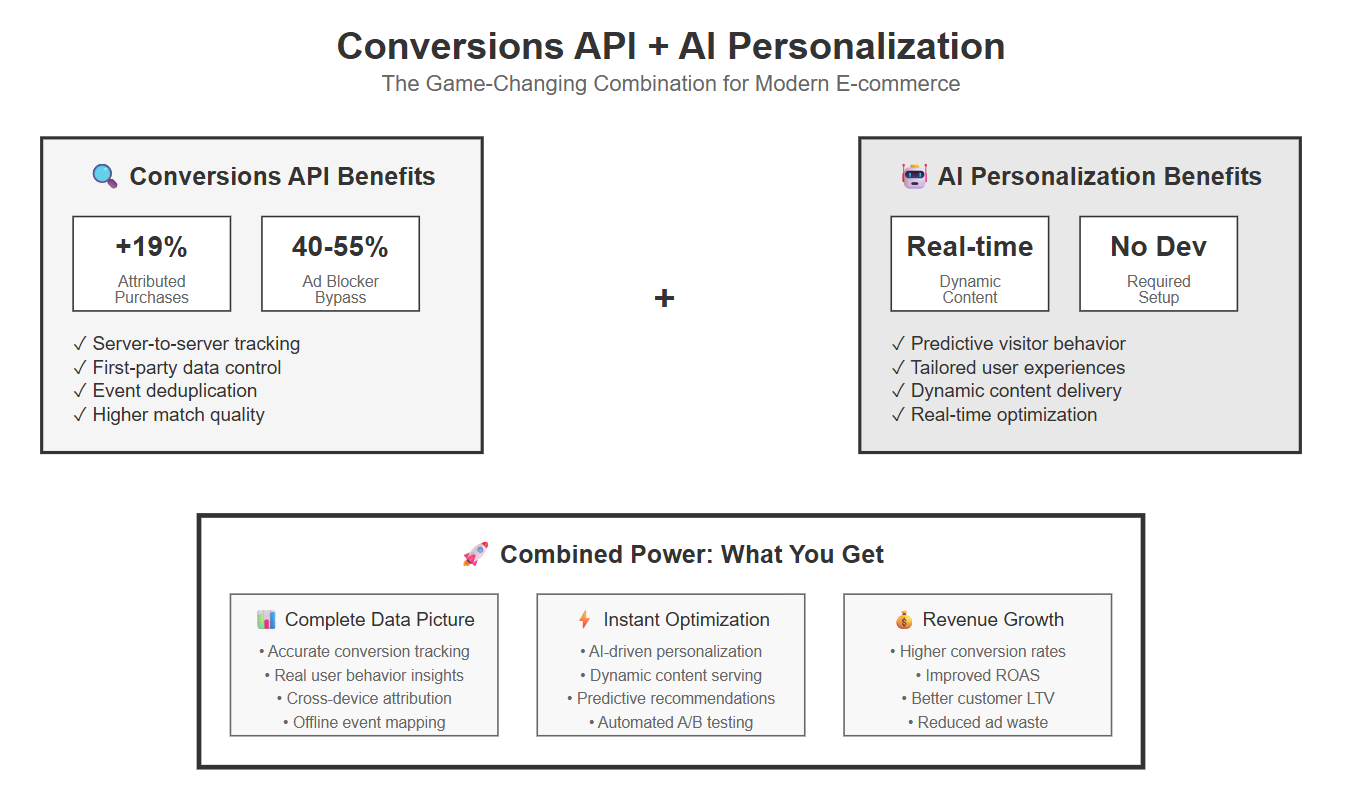
How to Set Up Facebook Conversions API on Shopify
If you’ve noticed a drop in your Facebook Ads performance or gaps in reported conversions, you’re not alone. Ad blockers now affect over 40% of global internet users (and up to 55% on desktop), which means a huge chunk of valuable interactions may never be recorded by traditional pixel tracking. For businesses in EduTech, FinTech, e-commerce, and banking, that’s not just a reporting problem—it’s lost revenue insight.
The solution? Shopify Facebook Offline Conversions Integration using Meta’s Conversions API. This server-to-server setup captures event data that browsers miss, improving attribution accuracy. In fact, advertisers leveraging CAPI have reported up to 19% more attributed purchases and higher event match quality scores.
In this guide, we’ll cover how to set up CAPI and offline conversions on your Shopify store in just a few clicks, why it’s a game-changer for conversion tracking, and how pairing it with AI personalization can transform tracking data into actionable marketing insights.
Quick Takeaways
- Over 40% of users now block ads, meaning browser-based tracking via pixels can miss nearly half your conversions, especially on desktop, where usage climbs to 55% cropink.com.
- Companies with ≥90% server-side event coverage and high Event Match Quality have seen up to a 19% lift in attributed purchases, and some report 20% more Meta‑attributed conversions.
- Meta’s Conversions API drives more accurate data capture, bridging gaps created by ad blockers and browser limitations (a known issue affecting ~40% of users globally).
- Shopify’s built-in native integration delivers this powerful setup in just a few clicks, activating reliable conversion tracking without code.
- Using server-side data and event deduplication ensures clean metrics by preventing overcounting from browser and server events.
Understanding Conversions API vs Facebook Pixel
What is the Conversions API and Why Use It
The conversion api (CAPI) is a server‑to‑server integration that transmits conversion events directly from Shopify to Meta, bypassing browser limitations. Unlike the Facebook Pixel, which relies on the user’s browser, CAPI ensures accurate tracking even when ad blockers or browser restrictions kick in.
Why Server-Side Tracking Is a Game Changer
Server‑side integration puts you in control of first-party data and helps overcome missing browser activity. This method is especially useful in a world where privacy controls and cookie restrictions are tightening. When paired with Pixel, CAPI improves match quality and ensures event deduplication—so you’re not overcounting conversions.

What Are Facebook Offline Conversions and Why They Matter
Facebook Offline Conversions let you attribute in-store purchases, phone orders, or other offline events to your ad campaigns. For instance, a school or academy that runs ads and later tracks enrollments offline can now see which ads performed best. This feedback loop helps optimize real-world outcomes and enhances ad targeting and ROI.
Step-by-Step: How to Connect Shopify to Facebook (Meta) Offline Conversions
Getting Meta’s Conversions API running in your Shopify store is easier than many think, thanks to Shopify’s native integration. Here’s a complete breakdown of how to connect Shopify to Meta’s Events Manager and ensure your conversion tracking is accurate.
1. Confirm Prerequisites
Before starting, make sure you have:
- A verified fb page and access to Meta Business Manager.
- A Facebook app connected to your business account.
- An installed and active Facebook pixel in Shopify (this is essential for event deduplication when using both browser events and server-side events).
- Admin access to your Shopify website.
2. Install the Facebook and Instagram App in Shopify
- Go to Shopify Admin → Settings → Apps and sales channels.
- Click “Shopify App Store” and search for “Facebook and Instagram” by Meta.
- Click Add app, then Install.
(This app is the official native integration for CAPI and removes the need for manual code.)
3. Connect Shopify to Your Facebook Assets
- Inside the Facebook and Instagram app, click Start setup.
- Log in to your Facebook account.
- Select your fb page
- Select the ad account you’ll use for campaigns
- Select your Facebook pixel
- Select your catalog (optional, but recommended for dynamic ads).
- Click Connect Shopify to link assets to your Shopify store.
4. Configure Data Sharing Settings
- In the same app, go to Data sharing settings.
- Set to Maximum to enable both browser events from the pixel and server events from the conversions API.
- This ensures more control over event data and improved match quality for ad targeting.
5. Verify in Meta’s Events Manager
- Go to Meta’s Events Manager (business.facebook.com/events_manager).
- Select your Facebook pixel.
- Look under Test events—trigger a conversion on your Shopify store (e.g., add to cart) and check that both browser and server events appear.
- Confirm the event match quality score; aim for as close to “High” as possible.
6. Enable Event Deduplication
Setting Up Facebook Offline Conversions
Facebook offline conversions let you connect offline events—sales in-store, phone orders, or other physical interactions—to your online ad campaigns. Here’s how to create, connect, and automate your Facebook offline conversions integrations for accurate tracking.
Create an Offline Event Set
In Meta’s Events Manager, under Offline Events, create a new event set or dataset for mapping offline data.
Upload Offline Event Data
You can manually upload a CSV containing fields like event name, time, value, currency, and user identifiers (email, phone) from CRM or POS systems.
Schedule Regular Updates
Uploading offline data regularly keeps your conversion tracking fresh and helps Meta’s algorithm better optimize your ad campaigns.

Best Practices for CAPI and Offline Conversion Tracking
Implementing Meta’s Conversions API and Facebook offline conversions is only half the journey—maximizing their impact requires following proven best practices. These steps ensure accurate tracking, better ad targeting, and higher ROI from your ad campaigns.
1. Combine Pixel and Conversions API for Maximum Coverage
The Facebook pixel remains valuable for capturing browser events, but it can’t track every interaction due to privacy restrictions and ad blockers. Pairing it with server-side events from the conversions api creates redundancy and fills gaps in your event data. This hybrid approach is essential for a complete picture of the customer journey.
2. Set Data Sharing Settings to Maximum
In Shopify’s data sharing settings, choose Maximum. This setting activates both pixel and server data flows, increasing match rates and allowing Meta’s Events Manager to identify more users. More matched events mean better ad targeting and more efficient ad spend.
3. Maintain High Event Match Quality
A High match quality score in Meta’s Events Manager indicates that Meta can confidently attribute actions to users. Boost your score by sending rich first-party data such as email, phone number, and location. This improves conversion tracking accuracy for both online engagement and offline events.
4. Update Offline Conversions Regularly
Offline data should be uploaded—or automatically synced—at least once a week, if not daily for high-volume stores. Timely uploads give Meta’s algorithm fresh conversion events to learn from, enabling faster optimization of your marketing strategies.
5. Deduplicate Events to Avoid Inflated Metrics
When both browser and server events are active, event deduplication prevents double-counting. Shopify’s native integration sends a unique event_id with each interaction, which Meta uses to merge duplicates. This ensures your conversion tracking reflects reality.
6. Segment Your Data Sources
If your business has multiple locations, POS systems, or sales channels, segment your data sources in Meta’s Events Manager. This enables deeper insight into which locations, channels, or campaigns drive the highest value.
7. Use AI to Personalize and Predict
Data without action is wasted. Pair CAPI insights with AI personalization and AI prediction to create dynamic website experiences tailored to each visitor’s behavior. This turns tracking into a game-changer for both conversion rates and marketing efforts.
8. Test, Measure, and Iterate
Review Meta’s Events Manager regularly to ensure events are firing correctly. Test new conversion events (like add-to-wishlist or lead form submissions) to capture the entire customer journey, not just final purchases.
Real-World Example: How CAPI + Offline Data Boost ROI
Imagine an EduTech platform running lead gen ads that generate inquiries. Many convert offline through demo calls or school visits. By syncing these offline enrollments via Facebook offline conversions and combining them with CAPI-tracked site engagement, the platform could pinpoint which campaigns drove real enrollments. The result? Higher conversion rates, smarter ad spend, and better marketing efforts.
Common Pitfalls and How to Avoid Them
| Pitfall | Fix |
|---|---|
| Forgetting to enable Maximum data sharing | Always set data sharing settings to Maximum |
| Skipping event deduplication | Ensure both Pixel and CAPI are firing and deduplicating |
| Irregular offline data uploads | Schedule consistent updates for accurate conversion mapping |
| Not using diverse data sources | Leverage both server events and offline events for full insight |
AI Amplifies the Power of Conversions API
Integrating your Conversions API setup with FunnelFlex’s Website AI Personalization and AI Prediction tools adds depth: real-time dynamic content, tailored UX, and predictive visitor behavior—without developers or static A/B tests. That is the true game changer for modern SGMs across EduTech, FinTech, and e-commerce.

Conclusion
You’ve just unlocked the blueprint for Shopify Facebook offline conversions integration—a robust combo of Facebook pixel, conversions api, and Facebook offline conversions that bridges your online ad spend with tangible, real-world results. This integration is not just about tracking; it’s a powerful layer of accuracy and control over your conversion tracking, especially when browser limitations and privacy barriers threaten your visibility.
Setup is seamless—Shopify’s native integration means you can get this running in a few clicks. Prioritize Maximum data sharing settings, enable event deduplication, and update offline event data regularly to keep your metrics clean and reliable. The result? Smarter ad campaigns, optimized ad targeting, improved ROI, and a clearer view of customer touchpoints.
What sets high-performing brands apart is what comes next: layering AI-driven personalization onto these insights. That’s where FunnelFlex’s AI Personalization and AI Prediction services transform data into tailored user experiences and predictive offers in real time—no developers needed.
Ready to turn tracking into conversion-driving intelligence? Empower your marketing strategies with tools that do more than track—they personalize and predict. Let’s bring results to life.
FAQs
Can you integrate Shopify with Facebook?
Yes—Shopify offers native conversions api integration that connects your Shopify store and Facebook app with just a few clicks.
How do I set up a conversion API on Facebook Shopify?
Install the Facebook and Instagram apps in Shopify, set data sharing to Maximum, then enable conversions api through Shopify’s partner integration in Meta’s Events Manager.
Is the Facebook conversion API free?
Yes—the Conversions API itself is free, but ad spend and Shopify plan costs apply.
What is the rate of pixel events covered by the conversions API Shopify?
Shopify CAPI covers key conversion events with high match quality when using Maximum data sharing settings alongside the Facebook pixel.
How do you put your Shopify store offline?
You can temporarily pause or close the store via the Shopify admin under Store settings → Plan.
